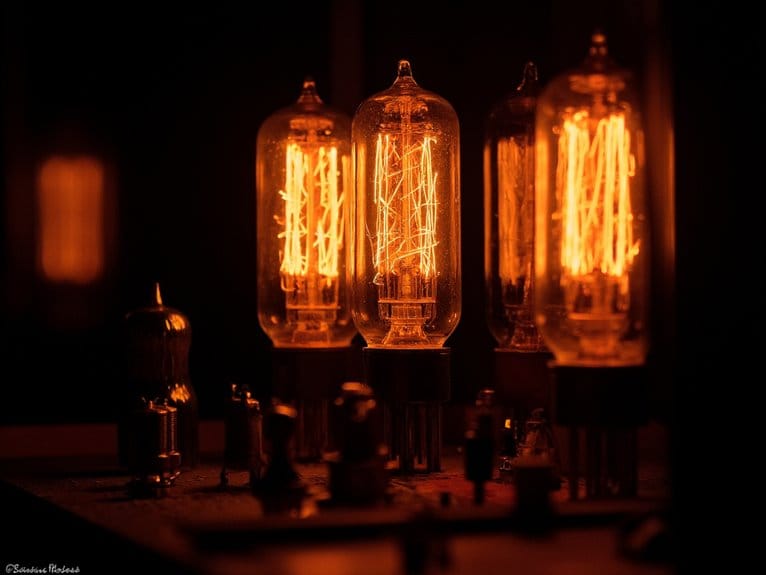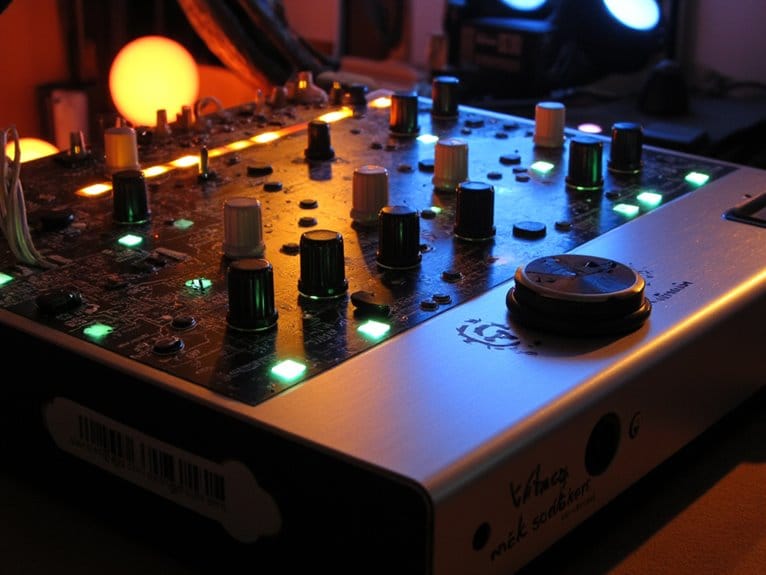Guitar Pickup Magnets: Alnico Vs Ceramic
You’ll find alnico magnets deliver warmer, more dynamic tones with superior touch sensitivity, while ceramic magnets produce higher output with stronger magnetic fields that drive amplifier distortion more efficiently. Alnico pickups, made from aluminum, nickel, and cobalt, peak around 4,000 Hz for brighter articulation, whereas ceramic magnets peak at 2,900 Hz for darker sustain. Your choice depends on genre preferences-alnico suits vintage blues and jazz, while ceramic excels in aggressive metal applications, and exploring their construction reveals even deeper tonal implications.
We are supported by our audience. When you purchase through links on our site, we may earn an affiliate commission, at no extra cost for you. Learn more.
Notable Insights
- Alnico magnets contain aluminum, nickel, and cobalt while ceramic magnets are made from iron oxide and strontium carbonate ferrite.
- Ceramic pickups produce higher output signals and stronger magnetic fields, making them ideal for driving amplifier distortion effectively.
- Alnico magnets deliver brighter, more articulate tones with richer harmonic content and superior dynamic response to playing technique.
- Ceramic pickups peak at 2,900 Hz creating darker tones, while Alnico peaks around 4,000 Hz for brighter sound characteristics.
- Alnico suits vintage styles like blues and jazz, while ceramic excels in aggressive genres like metal and hard rock.
Magnetic Composition and Construction Differences
While I’ve spent countless hours comparing pickup magnets in my workshop, the fundamental differences between Alnico and ceramic compositions reveal why these two magnet types produce such dramatically different tonal characteristics in electric guitars.
Alnico magnets combine aluminum, nickel, and cobalt with small amounts of copper, creating individual pole pieces that run directly through the pickup coil. Alnico II offers warmth with a softer attack, while Alnico V delivers clarity and higher output for enhanced performance.
Alnico’s aluminum-nickel-cobalt composition forms individual pole pieces that thread directly through pickup coils, creating precisely focused magnetic fields.
Ceramic magnets, conversely, use iron oxide and strontium carbonate ferrite compounds positioned as single slabs beneath metal pole pieces. Both pickup configurations feature metal pole pieces that are carefully wound with copper strands to complete the electromagnetic circuit.
These distinct manufacturing techniques result in fundamentally different magnetic field shapes and strengths. Ceramic magnets deliver higher output and strong bass response, making them particularly suitable for heavy playing styles and musicians seeking aggressive tones.
Alnico’s focused pole piece design generates localized magnetic fields, while ceramic’s broader slab construction creates wider coverage patterns that interact differently with your guitar strings. The stronger magnetic field from ceramic magnets produces more powerful string interaction compared to their Alnico counterparts.
Sound Output and Magnetic Strength Comparison
Beyond the structural differences that shape these magnets’ physical properties, the most noticeable performance gap between ceramic and Alnico pickups emerges in their sound output levels and magnetic field strength characteristics.
You’ll find ceramic magnets deliver markedly higher output signals through their stronger magnetic fields, which interact more intensely with your guitar strings, creating louder pickups that drive amplifier distortion more easily.
In contrast, Alnico magnets produce weaker magnetic pull, generating lower output signals that contribute to superior output dynamics and more expressive tonal variation with your playing technique. Alnico pole pieces generate approximately 700G pull on strings compared to 350G for ceramic configurations, affecting both sustain characteristics and overall tonal response.
While ceramic pickups offer impressive magnetic efficiency and signal strength, they create more compressed, less dynamic responses compared to Alnico’s naturally responsive character.
Tonal Characteristics and Frequency Response
When you’re comparing the actual sound characteristics between these pickup types, I’ll tell you that Alnico magnets consistently deliver brighter, more articulate tones with enhanced treble and midrange frequencies that peak around 4,000 Hz, creating that crisp, cutting quality you hear in classic rock and blues recordings.
| Characteristic | Alnico | Ceramic |
|---|---|---|
| Peak Frequency | 4,000 Hz | 2,900 Hz |
| Harmonic Content | Broader frequency response | Narrower bandwidth |
| Tone Clarity | Higher Q factor, pronounced clarity | Reduced voltage at treble peak |
| Dynamic Range | Wide, touch-sensitive | Compressed, consistent output |
Ceramic pickups peak lower at 2,900 Hz, resulting in darker tones with less harmonic complexity. While you’ll get more sustain and bass response from ceramics, Alnico’s frequency nuances provide approximately 1,000 Hz more harmonic content above ceramic’s peak, delivering richer overtones and superior note definition. The choice of magnet material affects your instrument’s tonal balance similarly to how brass saddles produce warmer tones compared to zinc alloy alternatives in bass bridge construction.
Historical Development and Modern Applications
The differences you’re hearing between Alnico and ceramic pickups didn’t happen overnight-they’re the result of nearly a century of magnetic innovation that began with a Japanese scientist’s breakthrough in 1933.
Tokushichi Mishima’s Alnico discovery doubled the coercivity of existing magnet steels, combining aluminum, nickel, and iron into an alloy that would define electric guitar tone for decades. While his patent was granted in 1936, World War II delayed widespread adoption until Fender embraced these magnets in the late 1940s.
The ceramic shift arrived in the 1960s when manufacturers discovered cheaper, more efficient alternatives, yet many guitarists preferred Alnico’s warmer character. This preference for distinct tonal qualities mirrors how musicians choose instruments based on key action type, where the physical response significantly influences musical expression and dynamic range. Just as beginners often prefer nylon strings over steel for their gentler feel, pickup selection reflects personal comfort and tonal preferences that shape the learning experience.
Today’s market reflects this division-ceramic magnets dominate high-output applications while Alnico variants like Alnico 2 and 5 preserve vintage tones that shaped rock, blues, and jazz history. Modern pickup designs like the Epiphone Alnico Classic PRO humbuckers demonstrate how Alnico magnets continue to deliver quality sound that captures authentic vintage tones at accessible price points.
Choosing the Right Magnet Type for Your Playing Style
After decades of working with guitarists who’ve struggled to find their perfect tone, I’ve learned that choosing between Alnico and ceramic pickups isn’t about following trends-it’s about matching magnetic characteristics to your musical DNA.
Your pickup preferences should align with how you actually play, not what looks cool online. If you’re chasing vintage dynamics and touch-sensitive response, Alnico magnets deliver that expressive quality where every nuance of your attack translates through the amp. Conversely, ceramic magnets excel when you need consistent high output for aggressive styles.
For heavy metal performances, ceramic magnets are recommended for their balanced low-end response and enhanced sustain qualities during palm muting techniques.
When building your first electric guitar setup, many guitarists benefit from HSS configurations that combine both magnet types for maximum versatility across different playing situations.
Understanding how pickup height affects your magnetic field interaction helps optimize both output level and tonal characteristics for any playing technique.
| Magnet Type | Best Genres | Playing Style Match |
|---|---|---|
| Alnico 2 | Blues, Jazz | Clean, expressive |
| Alnico 5 | Rock, Country | Versatile dynamics |
| Ceramic | Metal, Hard Rock | High-gain aggression |
Consider your genre suitability requirements-vintage warmth versus modern bite determines your ideal magnetic foundation.
Frequently Asked Questions
Can I Replace Ceramic Pickups With Alnico Magnets in My Existing Guitar?
You can replace ceramic pickups with alnico magnets, but pickup compatibility requires careful consideration. Simply swapping magnets without rewinding coils creates significant tonal differences and lower output that may affect your guitar’s performance unexpectedly.
How Much Do Alnico Pickups Typically Cost Compared to Ceramic Pickups?
You’ll find alnico pickups cost considerably more than ceramic ones due to expensive materials and manufacturing. This affordability comparison shows ceramic pickups under $50 while alnico ranges $100-$1000+, reflecting market demand for premium tonal qualities.
On a final note
You’ll find that choosing between alnico and ceramic pickup magnets ultimately comes down to your musical priorities and playing style. If you’re chasing vintage warmth, dynamic response, and that classic PAF sweetness, alnico’s your best bet. Need aggressive output, tight low-end control, and modern high-gain clarity? Ceramic’s got you covered. Don’t overthink it-trust your ears, consider your amp pairing, and remember that great tone starts with your fingers anyway.







